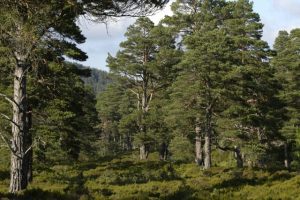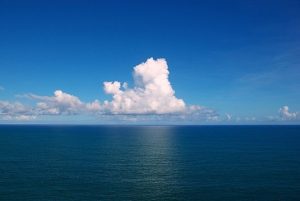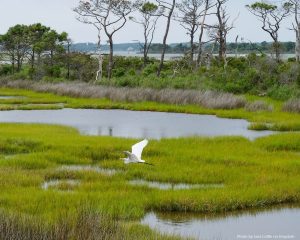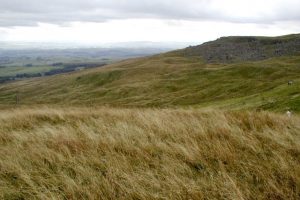Why are Carbon Sinks Important?
Carbon sinks provide an important ecological service. They help regulate climate and mitigate greenhouse gas emissions in the atmosphere by absorbing and storing carbon dioxide. Carbon sinks absorb more carbon dioxide than they release and can be natural or artificial. Natural carbon sinks include forests, oceans, wetlands, and grasslands. Technology is improving allowing for artificial carbon capture and storage as well.
Forests as Carbon Sinks
 Forests cover almost one third of the land area on the planet and are incredibly efficient at taking in atmospheric carbon. Trees absorb carbon dioxide during photosynthesis and store it in their trunks, branches and leaves. Some of the carbon that is stored in the roots and leaves of trees will end up in the forest soil after they decompose. A recent study found that forests absorb between 3.1 and 3.9 billion metric tons of carbon per year, which is close to 50 percent of the carbon dioxide that was released from the burning of fossil fuels from 1990 to 2019.
Forests cover almost one third of the land area on the planet and are incredibly efficient at taking in atmospheric carbon. Trees absorb carbon dioxide during photosynthesis and store it in their trunks, branches and leaves. Some of the carbon that is stored in the roots and leaves of trees will end up in the forest soil after they decompose. A recent study found that forests absorb between 3.1 and 3.9 billion metric tons of carbon per year, which is close to 50 percent of the carbon dioxide that was released from the burning of fossil fuels from 1990 to 2019.
Forest capacity to take in CO₂ is threatened due to increased wildfires and deforestation. Data shared by the Global Forest Watch showed a 12 percent decrease in global tree cover between 2000 and 2022. Improved forest management like fire management, indigenous-led stewardship, and climate-smart forestry can help our forests thrive. Also, restoration and holding companies responsible for sustainable sourcing of timber products can help protect forest carbon sinks.
Oceans as a Carbon Sink
 Oceans cover about 71 percent of the Earth and play a major role in regulating the Earth’s climate. Ocean ecosystems absorb approximately 31 percent of carbon dioxide emissions from the atmosphere. Some of that carbon dioxide is used by phytoplankton and other ocean plants to produce food; the remaining carbon dioxide dissolves in the water making it more acidic. Over the past 200 years, the ocean has become 30 percent more acidic as it has absorbed more and more carbon dioxide. The ocean has been a key player in keeping CO₂ out of the atmosphere but for how long and at what cost?
Oceans cover about 71 percent of the Earth and play a major role in regulating the Earth’s climate. Ocean ecosystems absorb approximately 31 percent of carbon dioxide emissions from the atmosphere. Some of that carbon dioxide is used by phytoplankton and other ocean plants to produce food; the remaining carbon dioxide dissolves in the water making it more acidic. Over the past 200 years, the ocean has become 30 percent more acidic as it has absorbed more and more carbon dioxide. The ocean has been a key player in keeping CO₂ out of the atmosphere but for how long and at what cost?
More acidic water makes it difficult for phytoplankton to build shells and causes coral reefs to die, which in turn decreases the amount of carbon dioxide that is absorbed through photosynthesis in the ocean. Additionally, as temperatures rise due to the increasing amount of CO₂ in the atmosphere, ocean surface water warms as well. These warmer waters reduce the ocean’s ability to absorb carbon dioxide since cold water is better at dissolving CO₂. Increases in ocean surface temperatures can also contribute to glacial melting and disrupt the global converter belt, which also diminishes the ocean’s power to remove CO₂ from the atmosphere. Reducing fossil fuel emissions is one of the best ways to protect the oceans which are the world’s largest carbon sink.
Wetlands as Carbon Sinks
 Wetlands take up about 6 percent of the Earth’s land area and include surface land that is covered by water constantly or occasionally. Wetlands can be freshwater, marine or a combination of both. Some examples of wetlands include swamps, marshes, estuaries, tidal flats, and mangroves. Wetlands are known for naturally filtering water, but they also have the ability to store 50 times more carbon than rainforests. Wetlands are resilient and have the capability to develop quickly because of their fast-growing plant life. Carbon stored in wetlands can remain trapped in the soil for thousands of years due to the lack of oxygen which slows down decomposition.
Wetlands take up about 6 percent of the Earth’s land area and include surface land that is covered by water constantly or occasionally. Wetlands can be freshwater, marine or a combination of both. Some examples of wetlands include swamps, marshes, estuaries, tidal flats, and mangroves. Wetlands are known for naturally filtering water, but they also have the ability to store 50 times more carbon than rainforests. Wetlands are resilient and have the capability to develop quickly because of their fast-growing plant life. Carbon stored in wetlands can remain trapped in the soil for thousands of years due to the lack of oxygen which slows down decomposition.
The amount of wetland area is decreasing globally due to erosion, sea level rise, human development, pollution, and climate change. As wetlands decrease, we are losing critical carbon sinks. Some things that we can do to preserve wetlands is protect their habitat from new developments, use non-toxic products to reduce pollution runoff, and reduce the use of fertilizer.
Grasslands as Carbon Sinks

Grasslands take up approximately 20 to 40 percent of the Earth’s land area and are defined as areas where the main vegetation is grass. They are found in many parts of the world and can be called prairies, pampas, steppes, or savannahs. Grasslands are a carbon sink capable of holding approximately 30 percent of global carbon. Much of the carbon stored in grasslands is in the soil, which protects this carbon sink during fires and other habitat destruction. This differs from forests because much of the carbon in forests is stored in the trunks of trees which is released as CO₂ when they decay or burn.
Even though grasslands are resilient if they decrease in size, their ability to absorb carbon dioxide will also decrease. Some threats to grasslands include converting grasslands into agricultural land, overgrazing, the spread of invasive species, and widespread fires. Conservation strategies like pest management, nutrient management, and prescribed burning and grazing can help protect grasslands.
Connecting Carbon Dioxide Emissions, Carbon Sinks, and Climate Change
Carbon sinks are essential to regulating the Earth’s climate, but carbon dioxide is being released into the atmosphere at a higher rate than what the natural sinks can absorb. This is happening because of the use of fossil fuels for energy and transportation. Since less carbon dioxide is getting absorbed by carbon sinks each year, the concentration of carbon dioxide in the atmosphere continues to increase. This leads to more greenhouse gases continually trapping heat in the atmosphere and decreasing the effectiveness of carbon sinks. Reducing greenhouse gas emissions is essential to mitigating climate change and strengthening carbon sinks.
Carbon Sinks and Climate Change Lesson Plans
- Check out the lesson Counting Carbon that introduces carbon sinks to elementary students. In this lesson students will visualize how much carbon dioxide comes from automobile emissions and then how much of that carbon can be naturally absorbed by forests, oceans, wetlands, and grasslands.
- For older students check out People and Climate Change: The Data Is In and Carbon Crunch to explore the effects of increasing carbon dioxide emissions and make connections on how the Earth’s carbon sinks are impacted. Discuss how this creates a positive feedback loop which continually increases the amount of carbon dioxide in the Earth’s atmosphere leading to a warmer planet.
Image credits: Forest (phil smith/Ancient Caledonian Forest, Glen Tanar/CC BY-SA 2.0); Ocean (Tiago Fioreze, CC BY-SA 3.0, via Wikimedia Commons); Wetland (Photo by Sara Cottle on Unsplash); Grassland (Mick Garratt/Rough Grassland, Pikedaw Hill/CC BY-SA 2.0)


